As you drive along Robert E. Lee Blvd in the Lakefront area of New Orleans, in a pleasant neighborhood a few blocks from the London Avenue Canal, you’ll come across Jean Gordon Elementary. Sixteen months ago my girlfriend stayed late at work on Friday night, getting her kindergarten classroom ready for the children that would arrive the following Monday for the first full week of class. Those kids never did show up, because Monday morning Hurricane Katrina arrived instead. I’d like take you on a photo tour of Jean Gordon immediately after the storm and tell you a little more about what has become of the school since then.
More after the jump...
Jean Gordon wasn’t a magnet school, but it was different. It was a city-wide access school which meant that while it had to take students from the immediate neighborhood it could also choose to accept students from other districts. It also had a reputation as a good school so parents that cared about their children’s education worked to get their kids into Jean Gordon. The parents were a particular strength of the school. One week before the hurricane, parent volunteers where hard at work painting the buildings, getting them ready for the new school year. The same parents, working through the PTO, had also financed a new wing for the school – paid for by their own generosity, not by school board funds or tax levy – that was due to be paid off in the next year or so. Jean Gordon was a special place.
Unfortunately, no amount of parental involvement could overcome the low-lying area where the school was located or its proximity to one of the breached levees. At the height of the flooding, the school was submerged in 8 to 10 feet of water. In this aerial photo of the area, you can see the floodwaters up the eaves of the portable buildings at the back of the school.

As bad as it looks from the air, nothing prepares you for the reality of seeing the flood lines on the walls, chronicling the slow process of draining the city.
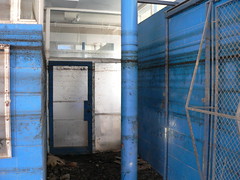
Large Image
Carolyn and I relocated not long after Katrina, first to Houston and then to Seattle so we’ve only seen the school a few times since the storm: early October when residents were getting their first look at the newly drained city; last May when we returned for a wedding and this past holiday season when we came back to visit relatives. The school remains essentially untouched, just a little dryer and dustier each time we return.
When we visit, we park on a side street near a downed section of fence by Carolyn’s classroom. From the street you can see this banner on the side of the parent funded wing of the school. Here it is in Oct. ‘05:
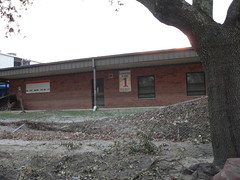
Large Image
And in May ‘06:
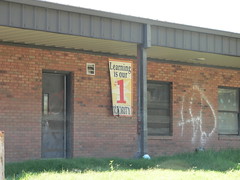
Large Image
And today in Jan. ’07:
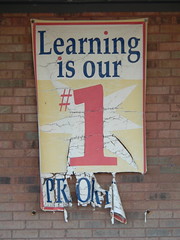
Large Image
In October I stuck my arm through a broken window to take this shaky one-handed picture of the inside of Carolyn’s classroom with the mud still wet on the floor of the room:
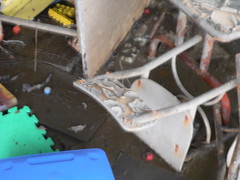
Large Image
Eight months later, most of the window was gone so that I could get a better shot. The chair and table in the previous picture are in the lower right corner of this one:
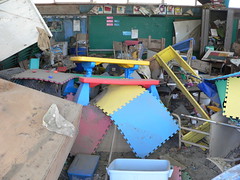
Large Image
Seven months after that, here’s her classroom from the door on the opposite wall, looking toward the window that the previous pictures were taken from. The large cabinet lying atop the pile of debris is the same one you can see in the upper left corner of the previous picture.
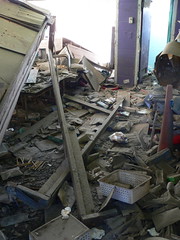
Large Image
Here are typical images from the other classrooms:
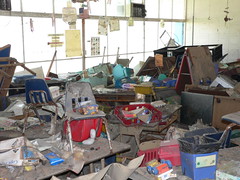
Large Image
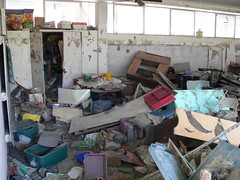
Large Image
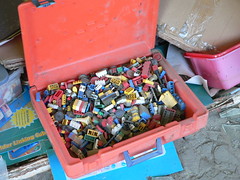
Large Image
The reason that the areas adjacent to the Mississippi river were such fertile farmland was the rich layer of silt that annual flooding would leave behind. Katrina demonstrated exactly how that process worked with the thick layer of muck that remained after the flood waters receded. Here is the covered assembly area immediately after the storm:
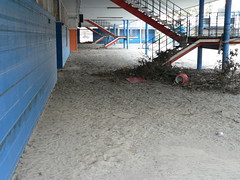
Large Image
And in May:
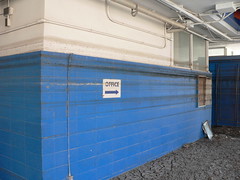
Large Image
And today:
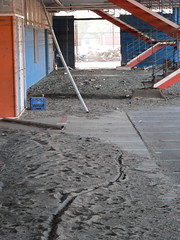
Large Image
The only problem was that the muck Katrina left behind wasn’t just rich river silt, it was a polluted mix of sewage, household chemicals and salt water from the tidal surge from the gulf into Lake Pontchartrain and then into the city. Last May, one of the few things that thrived in the school were these watermelon vines that grew from seeds that the kids gleefully spit from the watermelon served at Aqua Day at the end of the previous school year.
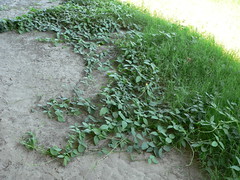
Large Image
In January we found this sadly appropriate mural of dinosaurs on a wall rising out of the dried muck, with flood lines still visible above the height of the door.

Large Image
One of the things that hits me the hardest are the cheerful encouragements that are still up on the walls and bulletin boards:
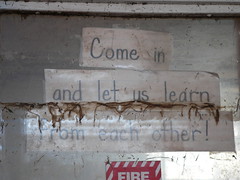
Large Image
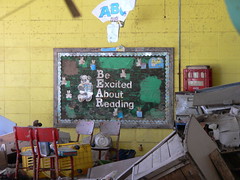
Large Image
In May, a sign on the door of one classroom a sign proclaims that Ms. Lenz’s Lions are roaring to learn.
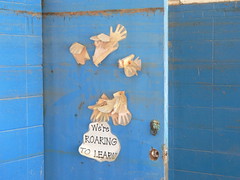
Large Image
In January, the desire is still there but the ability of the school district to do anything about it isn’t.
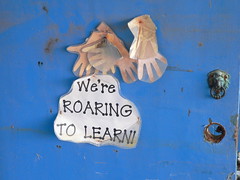
Large Image
Notice the lion door knocker on the Lion’s classroom. This is the sort of detail you found in many of the classrooms. Jean Gordon wasn’t an inner city combat zone; it was a place where teachers loved what they did and took the time to personalize their rooms to try and engage their students. The results of their efforts showed:
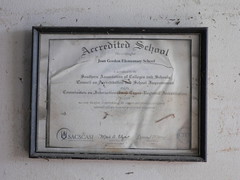
Large Image
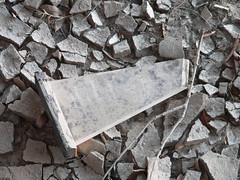
Large Image

Large Image
And what happened to those teachers? They were discarded just like the school. In a move that would make any Republican union buster proud, all of the teachers working for the New Orleans School District were fired a few months after Katrina, thus eliminating any need to abide by the union negotiated employment contract. Instead, they were graciously given the opportunity to apply to work with the new Recovery School District but their experience was capped at 12 years. It didn't matter if a teacher had devoted 30 years of their life to the New Orleans education system, the most they were given credit for was 12 years. Some of the teachers have gone to work for the Recovery District and others have found new jobs where ever they landed after evacuating and others have just moved on. Carolyn's first instinct after the storm was to want to stay and help rebuild the New Orleans school system, but six months of reading the school newsgroups and emailing back and forth with friends who went to work for the Recovery District made the decision to come to Seattle with me much easier to make.
The children who attended the school are scattered as well. Carolyn knows what happened to exactly two of her former students. She recognized one on television in Houston when he and his family were the recipients of one of the houses that Oprah donated to families that lost their homes in Katrina. Not long after the storm Carolyn checked the Times Picayune website hoping to see that the paper had resumed at least it's electronic version. Instead she found the last edition published before the storm and saw an article about a store-owner who had been murdered when he went to secure his store before evacuating with his family. She recognized the victim as the father of one of her ex-students and eventually tracked down her student and his mother in Atlanta, staying with relatives. Watching the coverage of events at the Super Dome was hell on Carolyn because she knew the that the odds were good that several of her students and their families would have sought refuge there.
In addition to buildings, teachers and students, an important part of what makes a school is the community where it is located. Prior to Katrina, the school was surrounded by a pleasant middle class neighborhood. The houses were mostly 60’s slab-on-grade construction with brick facing and streets lined with mature live oak trees. Here’s the side street by Carolyn’s classroom in Oct ’05:
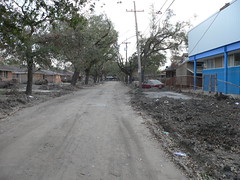
Large Image
At the far end of the street was this plea:

Large Image
And also this demonstration of the storm’s force:
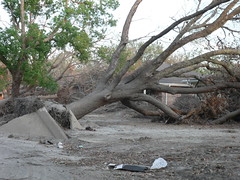
Large Image
Here’s the same side street in May:
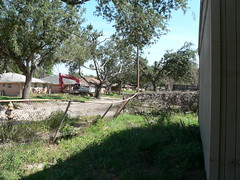
Large Image
There’s little evidence of any thing being done except for the one piece of heavy equipment in the picture.
A few blocks over, on the other side of the London Avenue Canal, there are a few FEMA trailers in place and one determined home owner is raising his house above the potential flood line. Note how what used to be the first floor of the house is now higher than the top of the FEMA trailer.
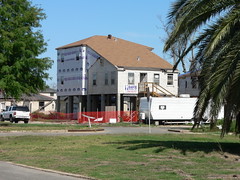
Large Image
By January of this year there’s been a bit more progress:
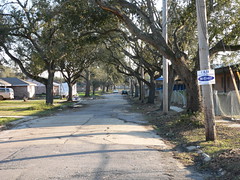
Large Image
A lonely FEMA trailer sits on the street beside the school. Several of the houses have been demolished and several others sport almost hopeless For Sale signs while about half of the houses seem untouched.

Large Image
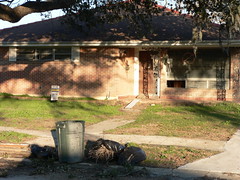
Large Image
Another common sign in the neighborhood:
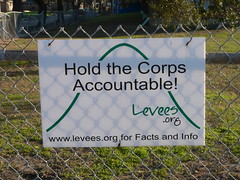
Large Image
One of the last things that Carolyn did that night she stayed late was to put up the Yesterday, Today and Tomorrow names on the board so that they would be waiting for the kids on Monday morning. Sixteen months later, even after being submerged for two weeks, those words are still up on the board, waiting for kids that won’t ever show up.
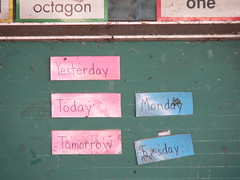
Large Image
----------------
Many thanks to luckydog for his excellent
Katrina Then and Now diary which provided the original idea for this diary.


